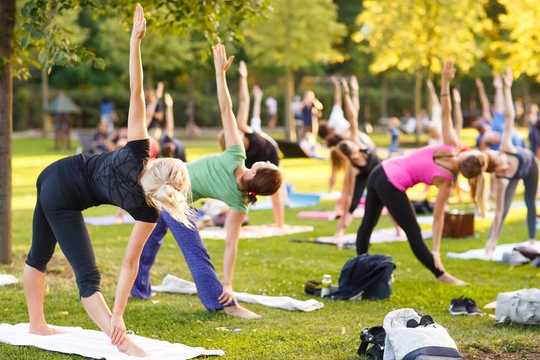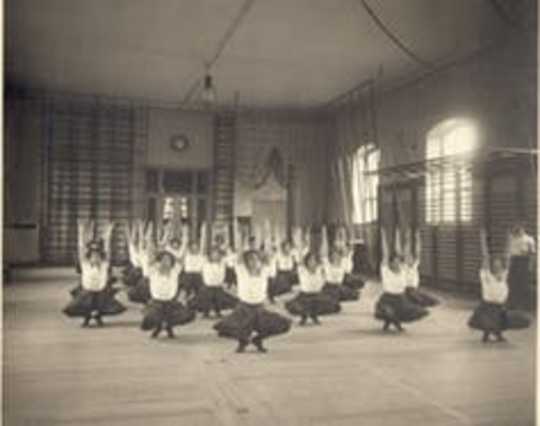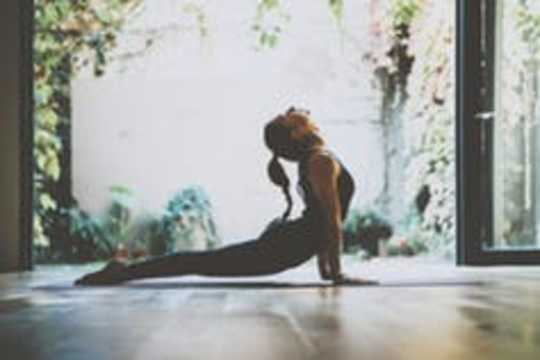 shutterstock
shutterstock
From the UK to Canada, China to India, around the world, yoga is big business. In 2016, Americans alone spent US$16 billion on yoga classes and products. To put that figure into perspective – this is the same amount allocated by the World Bank to help the entire continent of Africa tackle urgent climate change challenges.
But for many people, although they may well religiously attend their weekly yoga classes and enjoy sharing snaps of themselves mastering their latest yoga pose on Instagram, they might have less of an idea about where yoga itself (and the moves they are doing) actually come from.
So while most people know yoga is firmly rooted in the Indian tradition, what they might not know is the modern history – of how yoga left the shores of India and travelled the world to be influenced by gymnastics, bodybuilding and other non-yogic practices to evolve into what it has become today.
Communal stretching
Take the postures, yoga’s most visible and popular component – known as ?sanas in Sanskrit. These include downward dog, triangle pose and the tree – along with a whole other number of stretching and balancing positions. Well it turns out that similar postures can also be seen in Swedish and Danish gymnastic drills.
 Swedish gymnastics at the Royal Gymnastics Central Institute in Stockholm about 1900. Svensk litteraturhistoria i sammandrag auf/ Public Domain
Swedish gymnastics at the Royal Gymnastics Central Institute in Stockholm about 1900. Svensk litteraturhistoria i sammandrag auf/ Public Domain
There is good reason for this, because in the late 19th and early 20th centuries a culture of physical exercise swept the globe. These exercises were seen as very important, for this was a time where a strong body was equated with a strong country.
This preoccupation with national fitness also came at a time when the invention of photography was taking off. This meant that yoga postures, or ?sanas, that were being practised in India – which were notoriously tricky to describe effectively in words – could now be conveyed immediately and accurately through the new invention of photography. And cheap reproductive technologies brought yoga postures to the attention of the wider world for the first time.
Inside and outside India, books, manuals and magazines began to showcase ?sanas. In Europe and America people initially gawped at and ridiculed these poses as exotic or backwards. But the postures later gained popularity as remodelled Indian regimes of health and fitness.
This inevitably meant that European notions of gymnastics and bodybuilding got mixed up with Indian postures and poses along the way. And what many of us know today as yoga is partially a result of this mixing.
 The modern day yogi. Shutterstock
The modern day yogi. Shutterstock
This was particularly the case in European and American women’s “spiritual gymnastics”. Often born on the margins of “unchurched” protestantism, these diverse methods involved various positions and movements of the body, along with rhythmic breathing, to access the “divine” – much as yoga does.
And this modern entanglement of yoga with women’s spiritually focused exercise may help to explain why yoga is so popular worldwide among females today – with women making up more than 80% of practitioners in the US.
The new age
But of course, it doesn’t just stop there: breathing, relaxation and various varieties of meditation have all played their part in making yoga what it is today.
And as in the case of postural yoga – the usual yoga class you’d take at a gym or yoga studio that focuses on stretching and strength-building poses – these techniques have often become synthesised with nontraditional elements – like psychotherapy, western occultism, chiropractic, hypnosis, and forms of New Age religion. And this has also helped to take yoga in a totally different direction from it’s original roots.
This has also happened with yoga in modern urban India, where the movement has undergone what one scholar calls “the pizza effect”. Just like the pizza’s modern journey from Napoli to New York and back, yoga has travelled far beyond its homeland, and has assimilated diverse influences – returning back to India with new flavours and ingredients.![]()
About The Author
Mark Singleton, Senior Researcher in the Modern History of Yoga, SOAS, University of London
This article is republished from The Conversation under a Creative Commons license. Read the original article.
Books on Yoga from Amazon's Best Sellers list
"Light on Yoga: The Bible of Modern Yoga"
by B.K.S. Iyengar
This classic book is considered by many to be the definitive guide to yoga practice. The book covers the fundamentals of yoga practice, including asanas (postures), pranayama (breathing exercises), and meditation. It also provides detailed instructions on how to perform each pose, with clear illustrations and step-by-step guidance.
Click for more info or to order
"The Yoga Sutras of Patanjali"
by Sri Swami Satchidananda
This classic text is one of the foundational works of yoga philosophy. The book provides a comprehensive guide to the practice of yoga, including advice on how to cultivate the mind, body, and spirit. It also includes a translation of the original Sanskrit text, along with commentary and explanations.
Click for more info or to order
"Yoga Anatomy"
by Leslie Kaminoff and Amy Matthews
This book provides a detailed look at the anatomy of yoga postures, offering insights into the mechanics of the body and how different poses affect different parts of the body. The book includes detailed illustrations and explanations of each pose, along with information on how to modify poses for different levels of ability.
Click for more info or to order
"The Yoga Bible: The Definitive Guide to Yoga Postures"
by Christina Brown
This book provides a comprehensive guide to yoga postures, offering detailed instructions on how to perform each pose along with clear illustrations. The book covers a wide range of postures, from basic standing poses to more advanced inversions and arm balances.
Click for more info or to order
"The Heart of Yoga: Developing a Personal Practice"
by T.K.V. Desikachar
This book offers a unique perspective on yoga practice, emphasizing the importance of developing a personalized approach that takes into account each individual's unique needs and abilities. The book provides guidance on how to create a practice that is tailored to your own goals and preferences, with a focus on cultivating mindfulness and awareness.






















